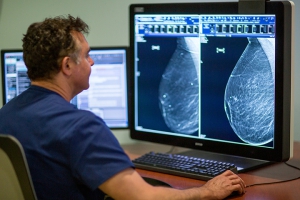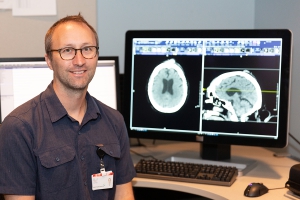The radiology specialty devoted to diagnostic imaging of the abdomen and pelvis utilizing primarily cross sectional imaging including MRI (magnetic resonance imaging) and CT (computed tomography or CAT). Diseases involving the liver, gastrointestinal system, pancreas, spleen, and genitourinary system are included in body imaging.
Breast Imaging and Intervention
The radiology specialty devoted to the diagnostic imaging and diagnosis of breast diseases and conditions. This includes mammography, breast ultrasound, breast MRI (magnetic resonance imaging), and breast procedures such as breast biopsy.
Cardiovascular and Thoracic Imaging
The radiology specialty devoted to the diagnostic imaging and diagnosis of diseases of the heart, vascular system (including blood and lymphatic vessels), and lungs. Primary imaging modalities include x-rays as well as CT (computed tomography or CAT), CTA (computed tomography angiography), and MRI (magnetic resonance imaging).
The radiology specialty devoted to the diagnostic imaging and diagnosis of trauma and non-traumatic emergency conditions. This includes x-rays, CT (computed tomography or CAT), ultrasound and MRI (magnetic resonance imaging).
A specialist in vascular and interventional radiology diagnoses and treats diseases with the use of various radiologic imaging technologies, including fluoroscopy, digital radiography, CT (computed tomography or CAT), ultrasound, and MRI (magnetic resonance imaging). Therapies include angioplasty, stent placement, thrombolysis, embolization, biliary and genitourinary drainages, abscess drainages, prostate artery embolization, and others.
The radiology specialty devoted to the diagnostic imaging and diagnosis of the muscles and the skeleton. This includes x-rays, CT (computed tomography or CAT), ultrasound, and MRI (magnetic resonance imaging).
A specialist in neuroradiology diagnoses and treats disorders of the brain, sinuses, spine, spinal cord, neck, and the central nervous system, such as aging and degenerative diseases, seizure disorders, cancer, stroke, cerebrovascular diseases, and trauma. Imaging commonly used in neuroradiology includes angiography, myelography, interventional techniques, CT, and MRI (magnetic resonance imaging).
includes angiography, myelography, interventional techniques, CT, and MRI (magnetic resonance imaging).
A specialist in pediatric radiology uses imaging and interventional procedures related to the diagnosis, care, and management of congenital abnormalities (those present at birth) and diseases particular to infants and children. A pediatric radiologist also treats diseases that begin in childhood and can cause impairments in adulthood.
A specialist in nuclear radiology uses the administration of trace amounts of radioactive substances (radionuclides) to provide images and information for making a diagnosis. Imaging that can involve nuclear radiology includes PET (positron emission tomography) and SPECT (single photon emission computed tomography) examinations.
